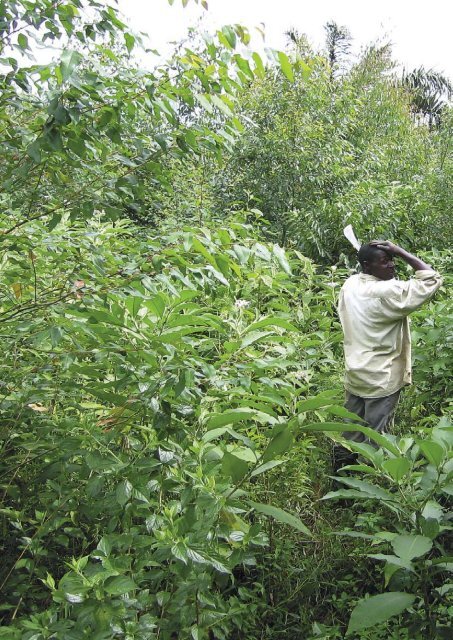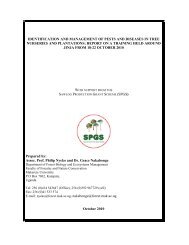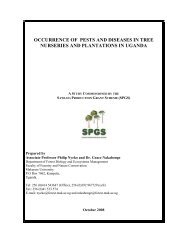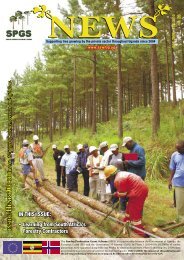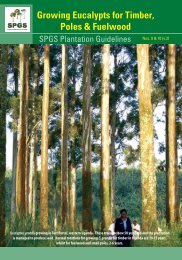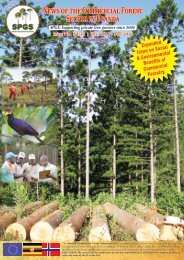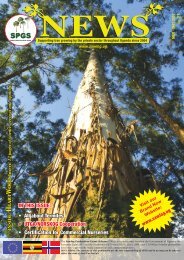Create successful ePaper yourself
Turn your PDF publications into a flip-book with our unique Google optimized e-Paper software.
SAWLOG PRODUCTION GRANT SCHEMECHAPTER 11COMMON WEEDS AND THEIR CONTROLStudy this Chapter and save yourself a lot of bother (and lots of Shillings too).T R E E P L A N T I N G G U I D E L I N E S F O R U G A N D A147
14811.1 IMPORTANCE OF WEEDCONTROLThe inclusion of this Chapter on weed controlbefore those on land preparation and planting isdeliberate so as to encourage the reader to think(and plan) for weed control well before planting.All too often those new to commercial forestryrush to plant their trees without having a clearweed control strategy in place. Planting into analready weedy site is a great mistake and severelyrestricts one’s options for weeding in the crops’early years too.There is no question that weed growth is the mainproblem confronting commercial tree growersin Uganda, leading to very costly control inthe early years of plantation establishment. Thecountry’s generally highly favourable conditionsfor tree growth, also leads to rampant weedgrowth and unless the weeds are controlledeffectively, the plantation investment will sufferseriously (and may even fail completely). As withmany silvicultural practices, however, carefulplanning can greatly reduce the impact of weedson tree growth as well as minimize the cost ofweed control.It is important tosee weed controlnot in isolationbut as one aspectof plantatione s t a b l i s h m e n t :and here we stressthe importanceof good planningand timing again.The better thesite preparationand the earlier thetrees are plantedin the rainy season,for example, thefewer weedingoperations will benecessary. Goodsilviculture is abalance of all theSAWLOG PRODUCTION GRANT SCHEMEavailable techniques such as good landpreparation, careful site-species matching, goodquality seedlings, timeous planting, quick beatingup and subsequent weed control.It has been clearly proven in many tropical andsub-tropical countries that intensive weed controlis highly beneficial to hardwood species – andespecially Eucalyptus spp. Eucalypts are particularlysensitive to grass and weed competition and foroptimum growth, it is always advisable to keepeucalypt plantations weed-free until canopyclosure (ca. 12 months in Uganda, providedweeding is done well - Schonau, 1988).Although pines are generally more tolerantof weed competition, trials have also clearlydemonstrated significant growth improvementswhere weeds have been removed from youngpine plantations. Most studies have shown,however, that it is not cost-effective to keep pineplantations totally weed free, unlike eucalypts.This Chapter describes the main weedsencountered in Uganda and recommends thebest approach to controlling them.Allowing weed competition like this will result in a failed plantation (Bushenyi, 2004).T R E E P L A N T I N G G U I D E L I N E S F O R U G A N D A
SAWLOG PRODUCTION GRANT SCHEMEIt should be stressed thatonly rarely is the approachrecommended to completelyeradicate a species (e.g. thecase of the highly invasiveLantana camara) but it is usuallya case of controlling the weedsto an acceptable level so thatour tree crop can establishand develop well. Chemicalsare only recommended whereconsidered appropriate andwhere they are, health andsafety considerations arestressed.11.2 WHAT IS AWEED?A weed is an unwanted plantor a plant that grows in an undesired place, in ourcase the tree plantations. Weeds have the abilityto grow fast and dominate an area very quickly:they thus compete against our desired (planted)crop. This competition deprives the planted treesof the nutrients, water, sunlight and space neededto grow quickly and with a good form. Weedyplantations are stressed, of poor form, stuntedand are susceptible to pest and disease attack.By weeding we remove this competition andother negative impacts of weeds thus helping toprovide the optimum growing environment forour tree crop. Weeds are more competent thanthe trees when it comes to growth and ability totap soil nutrients because of their characteristicslisted below: Efficient methods of seed dispersal. Ability to establish easily. Rapid and efficient reproduction. Rapid growth and aggressiveness ascompetitors. Well developed (and some times deep)root system. Adaptability, i.e. are able to grow in a widerange of habitats. Hardiness, i.e. able to withstand adversegrowing conditions. Difficult to eradicate.Ensure plantation staff know what the main weed problems are likely to be.Because of weeds’ efficient seed dispersal it isimportant to keep the entire area under control.Weedy areas provide a seed bank that keepsinfesting areas being managed. In addition to thecompetition for resources, weeds also provideshelter for rodents and a food source for cattleand wild antelopes: these animals will often thencause damage to the trees. Weeds also increase thefuel load within a plantation and thus significantlyincrease the fire risk during the dry seasons.Only with good weeding will youachieve the growth potential of the treecrop and make the returns expectedon the plantation investment.11.3 THE IMPACT OF WEEDS ONTREE GROWTHWeeds, just like any other crops, require water,soil nutrients and other resources for growth.They therefore compete with the trees for thesenecessities of life. Weeds have the followingnegative impacts on tree growth: They take up the nutrients that would havebeen used by the trees to enhance growth,thereby retarding tree growth.T R E E P L A N T I N G G U I D E L I N E S F O R U G A N D A149
SAWLOG PRODUCTION GRANT SCHEME Weeds once taller than the trees, shade 1. Fast growing, annual broad-leavedthem from sunlight: they thus impair tree weeds:photosynthesis and upward growth.A wide range of annual broad-leaved With severe weed competition, trees will weeds can emerge from the soil seed bankstruggle for the sun, often leading to malformedand compete with trees. These weedsor spindly (i.e. weak) tree stems.normally reproduce by means of seeds, They lower plantation hygiene and lead to and in most cases complete their life cycleplantation stress rendering the plantation in one year (after seeding). Although theysusceptible to pest and disease attack - e.g grow very fast, these weeds are generallyLeptocybe invasa (Chalcid wasp) attack in fairly easy to deal with by removing themstressed eucalypts.early enough before they compete with the Weeds provide fuel for forest fires; hence trees and before they set seed. The mostthey constitute afire hazard. They hampermovement withinthe plantation whencarrying out variousforestry operations– whether forroutine inspections,thinning or firefighting. Weeds may attractgrazing animalsinto the plantation,which in turn maydamage the trees. Weeds around thetrees attract rodentsand termites, which Ensure that the spray-team is well trained essential (NFA, Katugo, 2005).may then feed on the trees.common example is Black-jack (Bidens11.4 WEED IDENTIFICATIONpilosa), which can be found in all tropicalforesters’ socks.Before one can decide how best to controlany particular weed, it is essential to clearlyunderstand what weed problem one is dealingwith (or expecting). This entails having a basicknowledge of the main weeds, how they growand finally, knowing how to cost-effectivelycontrol the target species. Rather than using apurely scientific classification system, we havedeveloped a more practical way of classifyingthe main weeds that tree growers will encounterin Uganda. Under this <strong>SPGS</strong> weed classificationsystem, weeds are classified into six broadcategories as outlined below:2. Annual grass weedsAnnual grasses germinate from seed andreproduce in one year. Though easy tocontrol they need to be dealt with beforethey pose a serious threat to the trees.Sweet buffalo grass (Panicum schinzii) is oneexample of a common annual grass.3. Perennial, shrubby broad-leavedweeds:These weeds generally reproduce throughseed, but also through various vegetativestructures. They include coppice regrowth,150T R E E P L A N T I N G G U I D E L I N E S F O R U G A N D A
SAWLOG PRODUCTION GRANT SCHEMEinvasive species and climbers. They canimpair movement within the plantationto carry out the various operations ofpruning, thinning and harvesting. Theirmanagement can therefore be aimed atone or more phases of the life cycle suchas prevention of seed setting or exhaustionof underground roots. The best knownexamples are Lantana (Lantana camara),bramble (Rubus cuneifolius) and bugweed(Solanum mauritianum).4. Perennial grass weeds:These weeds are among the mosttroublesome for tree growers. They easilyspread and are particularly resilient tocontrol. They have a range of mechanismsfor propagation; seeds, rhizomes, stolons.They also constitute a serious fire threaton the plantation during the dry season.Management programmes should focuson prevention of spread, cultivation anddesiccation of roots. The main problemspecies are elephant grass, couch grass,spear grass and sugar cane.5. Woody weeds:These include indigenous tree regrowth(e.g. Combretum spp.), Eucalyptus spp.coppice and alien invader species such asPaper Mulberry (Broussonetia papyrifera)and Black Wattle (Acacia mearnsii).6. Sedges:These are biologically different fromgrasses and are very difficult to kill becauseof their underground rhizomes. Yellownutsedge (Cyperus esculentus) is common inwetter areas in Uganda.The main weed species mentioned in this sectionare described later in this Chapter after a moregeneral discussion of weed control.11.5 TIMING OF WEED CONTROLIt cannot be over-stressed that weeds willhave a negative impact on tree growth and theprofitability of the plantation business. Adequateweed control is crucial to achieve Fast Growing,High Yielding plantations. Weeds need to becontrolled until the trees themselves are able tosuppress them: thus the objective is always tominimize the time until what is termed ‘canopyclosure’ – namely, when the trees’ branchestouch between the rows and start to cast shade.The timing of various weed control measures willdepend on the nature and intensity of the weedproblem. It is common to divide the controlmeasures into pre- and post-planting and theseare described in the following sections.Adequate site clearing: During landpreparation, vegetation that would have competedwith the trees is removed or controlled. This helpsto achieve high survival and rapid early growth ofthe planted trees. The indigenous trees and shrubsshould be cleared to as close to ground level aspossible for easier control of coppice regrowth.Chapter 13 gives details on the land preparationtechniques.Pre-plant spraying with Glyphosate:Pre-plant spraying with Glyphosate is often anextremely cost-effective way to control targetweed species, especially the tough, perennialgrasses. It only works well, however, whenthe planning and timing is right: this involvescareful timing of land clearance, lining out andpitting operations to coincide with the optimumtime for planting. The success of the operation,however, is closely related to the size (i.e. stageof development) of the target weeds and the levelof training and supervision of the spray team.The subsequent weeds are the annual broadleavedweeds that are easier to control even byslashing or lower concentrations of Glyphosate.NB. Chapter 12 should be studied before eventhinking of spraying.Early post-plant weed control (eithermanual or chemical): From the time ofplanting, the plantation should be kept weedfree. The weeds should be killed when they arestill young otherwise they become difficult todeal with once they have established.T R E E P L A N T I N G G U I D E L I N E S F O R U G A N D A151
Periodic follow-up weed control: It shouldbe noted that most weeds grow faster than thenewly planted trees. Adequate pre-plant sprayingand early post-plant weeding are not enough towipe them out. A follow up weeding programmeshould be developed to ensure that weeds are keptas low a possible until the trees are established. ForEucalyptus spp, an intensive weeding programmeshould be developed to ensure 100% weedcontrol. This ensures maximum growth of thetees and promotes plantation health.11.6 FREQUENCY OF WEEDCONTROLBecause weeds are resilient and prolific seeders,they are difficult to eradicate. With properplanning and timely weeding, however, theSAWLOG PRODUCTION GRANT SCHEMEweed intensity will reduce and it will be easierto remove the weeds. The interval betweensuccessive weedings will also increase. Weedingboth manually and with herbicides only removeweeds that have germinated: seeds will continueto germinate. Therefore follow up inspectionsand weeding will always be required.So once you have weeded an area, don’t walkaway and forget it: inspect it regularly. The timingof the next (follow-up) weeding is vital: leave ittoo late and the weeds will seed and you will beback at the beginning. Time it right and you willeradicate the weeds when they are vulnerableand before they have a chance to seed. This willresult in a lower weed infestation next time andpossibly a longer gap between weeding.Good spot weeding - the minimum required (Arthur Busingye, - Bushenyi, 2006).152T R E E P L A N T I N G G U I D E L I N E S F O R U G A N D A
SAWLOG PRODUCTION GRANT SCHEMEHighly organised contractor spraying team carrying out a pre-plant glyphosate spray. (Peak Timbers, Swaziland, 2009)The timing of the follow-up weedingoperation is a vital part of a costeffectiveweeding strategy: time it sothat you can eradicate the weeds whenthey are small.Always remember that weeding needs to be donebefore the weeds seed. A clue to when a weed isgoing to seed is when it flowers. If your weeds areflowering you need to get in and weed quickly.11.7 METHODS OF WEEDCONTROLWhen deciding on which method of weedcontrol to employ, it is important to know theweed profile of the plantation. Knowing thetypes of the problem weeds on the plantation orproposed plantation site will help in choosingthe most appropriate methods of dealing withthe weeds. There are three main categories ofweeding: chemical, mechanical and manual.The main features of each method are outlinedbelow.Chemical weeding: This involves the killingof weeds using chemicals called herbicides. Themajor herbicide used in forestry world-wide isGlyphosate (Glyphosate is the active ingredient).Glyphosate kills any green plant material so itis safer to use it in the pre-plant situation (i.ebefore the trees are planted), at least until oneis satisfied with the level of training of the sprayteam.When using Glyphosate in the post-plantsituation, it is essential to prevent it from cominginto contact with the planted trees. The herbicideis sprayed over the weeds while caution is takento prevent any from touching the trees. The treesshould thus be protected using buckets, cones orshields.Before any spraying is done, the spraying teamshould be trained in the basics. They should alsobe provided with protective working gear toprevent body contact with the chemical. Goodstorage of the chemical and proper disposal ofused chemical containers are also important.T R E E P L A N T I N G G U I D E L I N E S F O R U G A N D A153
Provided the spraying operation has been carriedout properly, the weeds remain where they werebut do not compete with the trees because theyare dead (or dying). If the area was very weedyit may increase the fire danger in the short termbut then so would a manual operation.SAWLOG PRODUCTION GRANT SCHEMEremove any competing vegetation. For the bestresults, mere cutting is not always adequate andsome cultivation by hoeing is always needed tokill weeds especially grasses and invasive broadleavedweeds. Manual weeding can be carriedout in a number of ways:Mechanical weeding. This is where mechanicalmeans are used to eradicate weeds: disking,ploughing, rotovating or slashing behind a tractorare examples. Using a hand-held brush-cutter toslash down weeds is another. Mechanical weedingcan be very cost effective, especially as large areascan be covered quickly. The main drawback,however, is having suitable conditions that enablethe tractor access throughout the plantation:tree stumps and slope often make it impossibleto carry out safely. Even where conditions aresuitable, great care must be taken not to damagethe tree roots - which with older seedlings will beexploiting the inter-row area where the tractorwill be passing. Where mechanical weeding isplanned, it is recommended to increase theinter-row plant spacing to safely accommodatethe tractor.Manual weeding. Manual weeding is themost common method for small-cale plantings.It involves reliance on man- power, which usessimple tools such as hoes, slashers and pangas toHoeing must never take place withina zone 20cm around the young tree:weeds in this zone need to be handpulledto minimize the disturbanceand damage to the young trees’ roots.Slashing: This is normally a full cover operationwhereby the entire area is slashed or a spotoperation where the weeds are only high incertain areas (e.g. the inter-row). There are nomajor skills required here but two points to noteare:The slashing needs to be done as low aspossible. People will tend to slash higheras it is easier. The vegetation is thinner andyounger therefore softer. Supervision mustensure that the slashing is done as close tothe ground as possible. This will reduce theslashing frequency. Care must be taken to not slash the topsof the treesoff (knownas ‘SheffieldBlight’). Oneway of reducingthis danger is byfirst doing a spotweed aroundthe tree, therebyexposing the treeand creating a gapbetween the weedsbeing slashed andthe trees. Anotheruseful method isby placing a stickbetween the treeEnsuring a 1m diameter pit is kept clear - the basic <strong>SPGS</strong> standard.and the weeds to154T R E E P L A N T I N G G U I D E L I N E S F O R U G A N D A
SAWLOG PRODUCTION GRANT SCHEMEbe slashed: this could be a walking stickthat the labourer moves with, keeping itbetween the slasher and the tree so thatit protects the tree from any misplacedslashing.Hoeing: Hoeing can be three differentkinds:Spot hoeing. The area immediatelyaround the tree is hoed and the rest is left,slashed or sprayed with herbicide. It isrecommended to weed a circular area ofa minimum 1 metre diameter (i.e. 0.5mradius) around each tree.Line hoeing. The tree line is hoed andthe inter-row (the row between the trees)is left, slashed or sprayed with herbicide.Line hoeing on a slope must be donealong the contour to prevent erosion andif it is going to be sprayed with herbicide,spraying with herbicide on a slope is alwaysdone on the contour. A 1 metre strip isnormally recommended for line weeding(i.e. 0.5m each side of the tree line).Zone 1- This is the area within 20cm of theseedling. There are many of the seedlings’ surfaceroots in this area. Weed infestation in this areatherefore will compete hugely on the seedling.Also because of these surface roots only handpulling of weeds should be done. A hoe scrapingoff weeds will cut and destroy the seedlingssurface roots. In this zone the competition is highso no weeds should be allowed.Zone 2- This is the area from 20cm to 1m fromthe seedling. This is another important areathat needs to be kept clear of weeds. Here theweeds compete for nutrients as well as spaceand sunlight. Hoeing can be done in this zone.In this zone weeds should be kept to a minimum.Any weeds must only be young and small (havinglimited root development).Zone 3- This is also called the inter-row. Smallyoung weeds will not compete directly with theseedling. However as they get taller and theirroot systems develop, they will compete. Alsomature weeds will seed and infest the other twozones. On slopes it is advised not to scrape thisarea, either use herbicide or slash to prevent soilFull cover hoeing. The entire areais hoed. This method must not be doneon erodable, steep slopes as there is novegetation to prevent erosion.NB. Hoeing must never take place within 20cmof the tree. The tree has many sensitive surfaceroots that will get damaged thus retard thegrowth if this area is hoed. Weeds in this zoneneed to be hand pulled.A weed control programme may make use of anycombination of the above weeding methods: eachsituation has its unique set of circumstances withregards to the weeds on the site and the situationregarding labour availability and skills’ level.ZONE 3ZONE 2ZONE 111.8 WEEDING ZONESThere are three main areas that need to beweeded:Weeding ZonesT R E E P L A N T I N G G U I D E L I N E S F O R U G A N D A155
erosion. In this zone weeds should be kept belowhalf a metre in height.SAWLOG PRODUCTION GRANT SCHEMEpre plant spray is carried out close to thetime of planting).11.9 HOW TO ACHIEVE COST-EFFECTIVE WEEDING1. Many of Uganda’s existing and potentialplantation sites have a climate andvegetation that encourages massive weedgrowth once the land is cleared andplanted. Therefore, step one of a goodweeding strategy will often be a good preplant herbicide application, which willhelp all subsequent weeding and give thetrees the best start possible (provided theTableSummary18: SummaryComparisonComparisonof DifferentofWeedingDifferentMethodsWeeding Materials2. Remember that the gap between the firstand second weeding may be short but thetime will increase as you do successiveweeding operations, as long as you don’tlet the weeds seed. If they seed you goback to step one.3. A good herbicide operation will give you alonger period between weeding comparedwith manual weeding. This is because itkills the weed not just chopping them inhalf or moving them around.Chemical Mechanical ManualPROS:Very cost effective ifcarried out well and at theright time.A well trained team cancover large areas eachday.Kills very persistentweeds (especiallyperennial grasses).The weeds are suppressedfor a longer timeCost effective if land iswell prepared from theplanning phase.Large areas can becompleted quickly.Relatively unskilled labourcan carry out job.Cheap (and widely available)tools.Can be carried out in allweather and on all types ofterrain.CONS:Weather dependent – notapplicable in rainy andwindy daysCan cause seriousdamage to the tree crop ifspray drifts duringoperation.Can be expensive if notproperly managed(herbicide willdisappear!).Safety issue with workersMust use well-trainedteam.Requires transport ofwater to fieldWeather dependent –some areas may not beaccessible when wet.Requires accurateplanting lines; fairly flatterrain and no obstaclesto tractor.Equipment is expensive:requires a tractor in goodworking order.With careless operatorcan cause serious rootdamage to trees.Does not necessarily kill theweeds.Very time consuming (i.e.expensive) when weedgrowth is heavy.Careless workers candamage tree roots (withhoes) or slice the tops oftrees (slashers / pangas)Physically difficult withcertain tough or wellestablished weed species.Cultivation creates idealseedbed conditions forweeds.High labour requirement156T R E E P L A N T I N G G U I D E L I N E S F O R U G A N D A
SAWLOG PRODUCTION GRANT SCHEMERSA companies have a zero tolerance of weeds in eucalypt plantations (Mondi, RSA, 2007).4. During the wet season it is important toturn over weeds when hoed out, (rootsin the air), if not they can just continue togrow in a new place.5. Get as much of the root out as possible.Weeds store nutrients in the roots, byremoving those nutrients it makes it moredifficult for the remaining roots to sprout.6. Slashing is quick and cheap but all it doesis make the weeds shorter. Other than ingrassy inter-rows, slashing should onlybe used as a preparation for a herbicideoperation. Better still spray before they gettoo tall.sooner it reaches canopy closure, the sooner youcan stop weeding. It is as simple as that!11.10 THE MAJOR PLANTATIONWEEDS IN UGANDAThis section focuses on the main problem speciescommonly found in tree plantations in Uganda.The first three are all ‘invasive’ exotic speciesthat have escaped cultivation and have become‘naturalised’ in their new environment, whilstthe next four species are all perennial grasses thatare difficult to control.Lantana camara (common name: lantanaor tick-berry).7. Refer to Section 11.8 on weeding zones.Weeds should not be tolerated within Zone1. Weeds should be kept to the minimum inZone 2 and never older mature weeds andweeds are allowed in Zone 3 but should bekept below half a metre in height.Remember the better the weeding, the quickerthe trees will grow; the quicker the trees grow,the sooner it reaches canopy closure and theLantana is a heavily branched, perennial shrubthat grows in compact clumps and forms densethickets. It is native to Tropical America and hasattractive flowers (in a variety of colours fromcream and yellow, to orange-red and even purple),which is why the plant was introduced into manygardens in the first place. Lantana invades forestplantation margins, savanna woodlands, watercourses, roadsides and degraded land. Its stemis usually covered with short, stiff hairs andT R E E P L A N T I N G G U I D E L I N E S F O R U G A N D A157
ecurved prickles. Its leaves are dark green, palerbelow, rough and hairy. It has glossy roundedfruits that are fleshy and purplish / black whenripe. These fruits are poisonous to children andlivestock.SAWLOG PRODUCTION GRANT SCHEMEburn them if possible). Allow the stumps to re-shootand when no more than kneeheight (less than half a metre),apply a full cover spray withGlyphosate (a 3% solution). Repeat this operation untilthe stump no longer shoots. The above steps will berequired to be done morethan once, so monitor the siteand spray on time. SprayingLantana is becoming an increasing problem in Ugandan plantations. late or not following up at allwill result in the re-establishment of theLantana.Solanum mauritanum (Bugweed, tobaccobush).Lantana reproduces mainly by seed, whichis spread by birds and some times by water. Itflowers throughout the year and the tiny flowersare grouped in clusters approximately 2.5cm indiameter. It has a pungent smell when crushed.Lantana forms dense, impenetrable thickets,which not only suffocates the desired trees butalso prevents access for management, fire fightingand harvesting. It can adapt to a variety of habitatsand is now rapidly spreading through out muchof Uganda.Control: Lantana eradication is laborious andexpensive and so any plants should be removedimmediately upon detection. Once it has becomea dense thicket, it becomesdifficult (and more expensive) toremove. When small individuallantana plants are found, theycan be best removed by manuallypulling them out completely. Thisis more easily done when thesoil is moist. In thickets of moreestablished lantana, a combinationof work is required namely:Bugweed is a branched shrub or small tree thatgrows up to 5m high. It grows on forest edges,on road-sides, on wasteland, in urban spacesand along water courses. Its stems are mostlycovered in whitish, felt-like hairs. Its leaves arelarge, dull-green and velvety above: the have astrong smell when crushed. The berries are firstgreen then yellow in compact clusters. Bugweedcauses serious problems in plantations as it canvery quickly reach a height that will shade outthe trees. Its fruits are attractive to birds, whicheat the berries and transport the seeds for longdistances to forest and scrub patches where theyroost. In young forest plantations, feeding birdscan perch on the young pine trees and break thegrowing tips.Cut off and remove thebranches (and carefullyBugweed must be controlled before it gains a foot-hold in one’s plantations.158T R E E P L A N T I N G G U I D E L I N E S F O R U G A N D A
SAWLOG PRODUCTION GRANT SCHEMEControl: eradication of Bugweed can be done inseveral ways:By cutting it down and painting the stemswith herbicides. Large numbers of seedsaccumulate in the soil so follow-up controlby hand or with herbicides is essential.By hand pulling them out when they arestill small, this is very effective.Herbicide application (using Glyphosateat around 1.5% solution or 2 litres perhectare) can also be done if the foliage canbe reached.NB. When mechanically cleared, the clouds offine hairs that are dislodged contain toxins thatmay cause respiratory problems in workersclearing these plants. In the control of bugweed,it should be noted that the smaller the bugweed,the better the results will be, as mature bugweedhas an extensive root system.Broussonetia papyrifera (Paper Mulberry).This deciduous tree occurs naturally in Japan andTaiwan but has become a major weed in manyarts of the world. Like many invader species, ithas spread from gardens where it was plantedas an ornamental shrub. It grows to a height ofabout 15m. Its twigs are hairy reddish brown;the bark is tan and smooth; the wood is soft andbrittle, opposite or whorled along the stem. Theleaf margin is sharply toothed; the leaf base isheart-shaped to round with pointed tips, and theupper leaf surface has a rough feeling. It exudes amilky sap when cut. The fruits are reddish purpleto orange, 1.5-2.0 cm in diameter.In Uganda, paper mulberry has taken over someareas of Mabira CFR, where the natural foresttrees had been cleared for agriculture in thepast. It spreads by seed and through vegetativeexpansion, by producing new shoots from theroots. Paper mulberry is highly invasive and canspread very quickly so prompt action should betaken once it is found on one’s plantation. Thepractice of harvesting small branches and leavesof paper mulberry to be used as animal fodder asPaper mulberry - a very agressive, woody weed.a means of control only assists in its spread andis thus not recommended. The control of PaperMulberry is most effectively done by eitherchemical or manual means:Chemical means: Basal bark, cut stem, hackand-squirt,or injection methods of herbicideapplication are recommended because thesemethods, if used properly, focus the applicationonto the target species, minimize the overallamount of herbicide applied and reduceenvironmental impacts.Basal bark application of the broadleaf systemicherbicide Garlon® 4 can also be used with a50% mix in water for cut stump applications.Herbicide can also be applied using a hatchetto make angled cuts into the trunk, into whichconcentrated herbicide is squirted from a handheldbottle. For this method, use a 10% mixtureof Garlon® 4 in horticultural oil, or a 15% ratefor larger trees. NB. Until Garlon® 4 or itsequivalent is available in Uganda, however, a highconcentration of Glyphosate (6 lt/ha or a 3%mixture can be tried).T R E E P L A N T I N G G U I D E L I N E S F O R U G A N D A159
Manual means: Pull seedlingsby hand when the ground is moistensuring that as much of the rootis extracted as possible to reducevegetative propagation. Seedlingsneed to be piled and burnt toprevent re-growth and spread.Multiple slashing operations will berequired for larger trees, ensuringthat all slashed material is collectedand burnt to prevent spread.SAWLOG PRODUCTION GRANT SCHEME160Panicum maximum (Guineagrass).This is a widespread vigorouslygrowing indigenous grass, aprincipal weed in agriculture and asource of great concern in forestry.It is a perennial tufted grass with ashort, creeping rhizome. It is robust with stems,which can reach a height of up (and in extremecases beyond) 2 m. As the stems bend and nodestouch the ground, roots and new plants areformed. The leaf sheaths are found at the bases ofthe stems and are covered in fine hairs. It remainsgreen until it ages, paving way for young shootsto grow.P. maximum prefers fertile soil and is well adaptedto a wide variety of conditions. It grows especiallywell in shaded, damp areas under trees and shrubsand is often seen along rivers. It has a high leafand seed production and is very palatable to gameand livestock. It is widely cultivated as pastureand is especially used to make good quality hay.If it receives adequate water, it grows rapidlyand occurs in abundance. In Uganda it is used tomake brooms. The harvesting process howeverleads to many seeds being dropped, which maygerminate leading to more infestation. It isimportant to control this grass early, as plantsthat are not controlled at an early stage developlarge perennial clumps. These clumps are tolerantto even the strongest herbicides and must usuallybe removed by hand (uprooting). Care must betaken to remove all germinating individuals asthese may establish very soon and out competethe trees.Elephant grass strongly competes with the young trees and must becontrolled before planting.Pennisetum purpureum (elephant grass,napier grass, Uganda grass).This is a tall, robust, perennial, tufted grass thatgrows forming bamboo-like clumps or thickstems up to 4.5 metres high. It grows on moistsoils in areas with over 1,000 mm of rainfallannually and widely distributed along the banks ofwatercourses. It grows best on deep, fertile soils.Its leaves are light green, blades up to 120mmlong and 30mm wide, the margins thickenedand spiny. It is usually cultivated for ornamentalpurposes and fodder. It invades forest margins,river-banks, valley floors in sub-Tropical regions.Its origin is Tropical Africa. It is a difficult grassto eradicate once it has established and requiresan integrated approach involving both manualand chemical means. A high concentration ofherbicide is required though. It is also important,easier and cheaper to eradicate elephant grasswhen it is still young (upon spotting).Cynodon dactylon (couch grass).Commonly known as Olumbugu (Luganda),this weed is thought to have originated inTropical Africa or Asia. It is now a widespreadand troublesome weed reported to be the mostwidespread grass weed in the world. It creepsalong the ground and roots wherever a nodetouches the ground, forming a dense mat.T R E E P L A N T I N G G U I D E L I N E S F O R U G A N D A
SAWLOG PRODUCTION GRANT SCHEMECouch grass forms a dense carpet.It is fast growing, tough and drought resistant.When damaged, it recovers quickly. It is alsohighly aggressive, crowding out most othergrasses and invading other habitats, and hasbecome an invasive species in some areas. Itreproduces by means of an extensive systemof stolons and underground rhizomes. It alsodisperses on animal hooves. It does not growvery tall, with a flowering stem rarely reaching40cm. The seed heads are produced in a clusterof 3-7 spikes together at the top of the stem, eachspike 3-6 cm long. It has a deep root system; indrought situations with penetrable soil, the rootsystem can grow to over2m deep, though most ofthe root mass is less than60cm under the surface.Imperata cylindrica(spear grass, cogongrass).This is a noxious grass weedin many regions of theworld and one of the mosttroublesome grass weedsin some tropical countries.It estimated that the totalcoverage of I. cylindricathroughout the tropics is2,000,000km² (naturalgrasslands included).This weed has a widedistribution, adaptation toa wide range of climatic conditions and soils.It has a high competitive ability. I cylindrica is aperennial grass growing up to 4m in height. Theleaves are about 20cm long and 2cm wide, have aprominent white midrib, and end in a sharp point.Leaf margins are finely toothed and are embeddedwith silica crystals. The upper surface of the leafblade is hairy near the base; the undersurface isusually hairless.It occurs in moist places, tending to take overonce it has established. It spreads by a system ofunderground rhizomes, which makes it difficult toBecause of its extensiveunderground system, thisweed is extremely difficultto eradicate. Repeatedploughing and harrowingwill give a fair degree ofcontrol by breaking upthe runners and exposingthem. This reduces theroot reserves and increasesthe efficiency of herbicideswhen they are applied onthe regrowth.Spear grass is very tough to control and must be pre-plant sprayed.T R E E P L A N T I N G G U I D E L I N E S F O R U G A N D A161
eradicate. It invades agricultural areas, coastland,natural forests, planted forests, range/grasslands,riparian zones, scrub/shrub lands, urban areasand wetlands. Normally, it does not occur inclosed forests but appears once the forests areopened up for agriculture or lumbering. Infact, I. cylindrica is very successful in areas thatare frequently burnt, overgrazed or intensivelycultivated; it rapidly colonizes disturbed sites.It is resistant to many control methods includingburning. Dry and vast I. cylindrica wastelandsare highly prone to frequent and intense fires,which destroy native vegetation and hamperthe succession of native plants by killing shoots.SAWLOG PRODUCTION GRANT SCHEMENatural regeneration of tree vegetation is usuallyretarded or impossible due to the weed’s highcompetitive ability. Following fires, I. cylindricaregenerates very rapidly from its undergroundrhizome system and may dominate on sitespreviously disturbed by slash and burn agriculturefor up to 7 years. Hand pulling is an option but isextremely labor intensive. Slashing will not helpmuch either.Burning alone is not an option, as it only stimulatesadditional weed growth. An integrated approachis best, utilizing burning to remove thatch layer,follow with mowing or dicing, and late seasonapplications of a broad-spectrum herbicide suchExcellent weed control in 3-mnth old E. grandis (James Finlay’s Mwenge Tea Estate, 2003).162T R E E P L A N T I N G G U I D E L I N E S F O R U G A N D A
SAWLOG PRODUCTION GRANT SCHEMEas Glyphosate. Follow-up herbicide treatmentsat 4-6 month intervals are needed to clean upnewly emerging weed.11.11 SUMMARYWeeds are public enemy no. 1 in plantationforestry as they compete with the trees fornutrients, light and water. It is thereforeimportant to keep plantations as free fromweeds as possible.The best way of controlling weeds inplantation forestry is by starting to controlthem before planting (i.e. pre-plant weedcontrol).REFERENCES AND FURTHERREADINGBromilow C, 2001. Problem Plants of SouthAfrica: a Guide to the identification andcontrol of more than 300 invasive plantsand other weeds. Briza Publications, RSA;pbk; 258pp.Schönau A.P.G., 1988. Requirements forIntensive Silviculture. Paper presented atIUFRO Symposium on Forest Research:Future Needs in South Africa. 21pp.Available from <strong>SPGS</strong>.Never let the weeds in a plantation getabove shin height or else they will bedifficult to control.Long-term maintenance requires that one’starget weeds be killed before they produceseed.Various methods of weed control canbe used for example chemical, manual,mechanical means and browsing. Anintegrated approach is usually the mosteffective especially on large, old establishedinfestations of weeds.Herbicides should be applied when theweeds are still actively growing. Timing isimportant to maximize cost-effectiveness.Prevention is by far better than cure;fight the weeds before they become wellestablished and hard to fight.Chemical weeding is often most costeffectivemethod of weed control incommercial forestry but this is only truewhen carried out properly, with adequatelytrained and carefully supervised staff.T R E E P L A N T I N G G U I D E L I N E S F O R U G A N D A163


